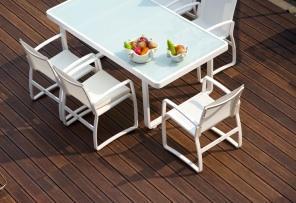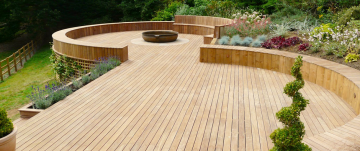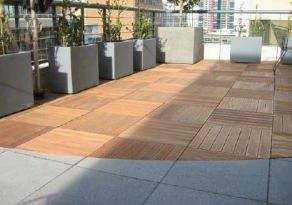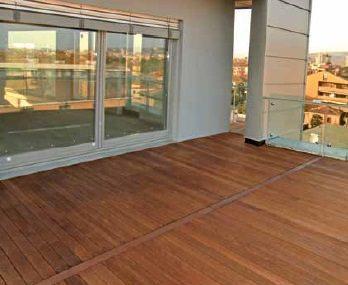Outdoor Wood Flooring
Post from EditorialsThe parquet is the easiest solution for outdoor use, ecological and stylish, it has a unique way to decorate the exteriors of our home, such as terraces and gardens.
Usually when we think about floors we think of a type of flooring that concerns only the interiors.
Actually it is not like this, in fact, there are also outdoor parquet flooring, that can be used both for simple terraces and for outdoor flooring in general, such as sidewalks, porches, platforms gazebo, pool surrounds, walkways along the beach, garden paths , etc ...
Characteristics of outdoor flooring
This type of flooring, whatever is the context in which it is used, gives to the room an elegant look, this happens because wood is a material that offers all these features. In addition, if treated and maintained with care, it lasts many years resisting even the most impervious weather conditions.
 Obviously the type of wood that you chose, it must be suitable to the outdoor conditions and it must be able to withstand moisture, rain and sun.
Obviously the type of wood that you chose, it must be suitable to the outdoor conditions and it must be able to withstand moisture, rain and sun.
One of the woods mostly used to make this type of flooring, and that does not compromise the environment due to its rapid renewability, is bamboo, which on the contrary of what everyone thinks, it is not a herbaceous plant, but a real tree; there are some real bamboo forests in the world.
This tree compared to all other kinds of wood that are usually used to make wood flooring, is the most resistant and it grows very fast, in just a few years. One of the companies that uses bamboo wood to create flooring for outdoor use is Iperceramica.
How to buy wood flooring for outdoor
This type of flooring is comercialized in the form of strips, whose sizes are superior to the common strips used for indoor parquet, in fact, these range from 70 to 140 mm in width and from 800 to 2000 mm in lengths, their minimum thickness is of 18-20 mm. Of course, size and thickness of the individual elements vary according to the use that we are going to make of the space that we are going to floor and then to the loads to which they will be subjected.
 Externally, the slats can be smooth or ribbed possibly with the rounded surface so as to make it pleasant to be walked on also barefoot. Fastening systems may include the use of joints, or of a support on which then will be barred every individual slats.
Externally, the slats can be smooth or ribbed possibly with the rounded surface so as to make it pleasant to be walked on also barefoot. Fastening systems may include the use of joints, or of a support on which then will be barred every individual slats.
For these types of floors there are some wood species that can be laid in place without undergoing any kind of protective treatment and that are able to maintain for very long periods their aesthetic and technical characteristics. These woods are Teak, Ipè, Iroko, Cardinal, Cumarù and other species, especially South American. Generally, a wooden floor made with these woods can last for about 20 years.  The wood used for external floorings can also be compared to plastic materials, which have the characteristics of having a good resistance to atmospheric agents, to be non-deformable and of low maintenance.
The wood used for external floorings can also be compared to plastic materials, which have the characteristics of having a good resistance to atmospheric agents, to be non-deformable and of low maintenance.
On the market it is easy to find solutions with tile/ wood panels of different sizes, modular panels are assembled on supports made with materials different from wood, such as pvc, metal etc. Generally to maintain the panels stable there are side connectors interlocking.
All this make of installation and removal, simple operations, giving to wooden floors a good drainage capacity, allowing in this way the installation of any type of surface. A company that you could contact for further information is Dècodecking .
Laying of parquet flooring for outdoor
To perform a correct installation of a wood parquet outdoor, you need to pay particular attention to certain aspects such as drainage and the slope of the substrate.
 In fact, since we are outside it is important that the substrate on which subsequently the flooring will be layed, is designed and implemented so as to ensure rapid draining and rainwater drainage. In addition, before laying the single slats you need to prepare the wood: the boards should be washed with plenty of water, so as to prevent the escape of tannins or other substances that can stain the same slats or other places nearby.
In fact, since we are outside it is important that the substrate on which subsequently the flooring will be layed, is designed and implemented so as to ensure rapid draining and rainwater drainage. In addition, before laying the single slats you need to prepare the wood: the boards should be washed with plenty of water, so as to prevent the escape of tannins or other substances that can stain the same slats or other places nearby.
This phase of the washing of the slats can be avoided when you decide to treat the surface of the parquet with special substances or oils to protect it. If you opt for this secondary treatment then you must also treat them also on the sides and at the points of support.
Usually when it comes to flooring for outdoor use, it is important to remember that this floor being placed outside is therefore going to be subject to rainfall and, in the laying of the different planks it is better to put some spacers, so as to allow more drainage of rainwater and greater aeration of the flooring package.
In addition, using a system like that you get a parquet floor very nice to see which is able to hide the normal slopes of the external flooring.
Wood Treatment for outdoor use
 It is well known that wood is a material that tends to absorb water and is very sensitive to temperature, for this reason, during the storage phase it is seasoned at a default fixed humidity degree, which is decided by the manufacturer depending on the type of wood he will want to get.
It is well known that wood is a material that tends to absorb water and is very sensitive to temperature, for this reason, during the storage phase it is seasoned at a default fixed humidity degree, which is decided by the manufacturer depending on the type of wood he will want to get.
In this way the slats are able to maintain a good dimensional stability at least up to the time of installation. In fact, generally the planks are stored in a covered, well-ventilated place, so as not to subject it to temperature changes that could alter the characteristics of the wood.
Subsequently, the entire realized surface of parquet is treated with protective mineral oils, which have the function to absorb the thermal shock, caused by the alternation of sun and rain, and to protect the surface from chemical and biological attacks of insects, of different parasites and from molds.
Advantages of parquet flooring for outdoor
Certainly one of the advantages of choosing the parquet flooring for outdoor use is its cost, its simplicity and the rapidity of the laying, also this type of flooring can be layed on existing floors and it also lends itself to compositions of designs, including the adoption of different types of woods and thus creating divisions of areas and routes. But the most important is its being environmentally friendly, providing excellent durability and resistance over time.
79810 REGISTERED USERS










